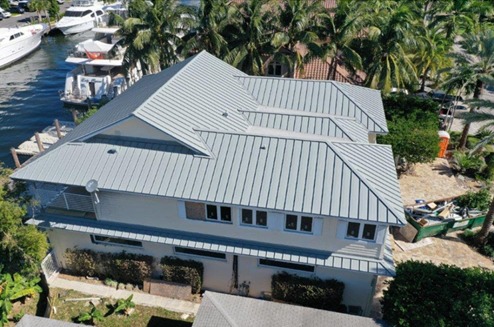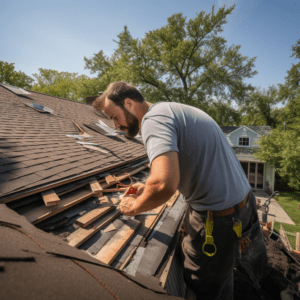While some may argue that the design and customization of a roof is purely aesthetic and unnecessary, the reality is that customizable roof options offer a multitude of benefits beyond mere appearance. This article aims to provide an in-depth exploration of the various types of customizable roof materials, their associated benefits, factors to consider when selecting such options, as well as how they can be tailored to different architectural styles. Additionally, it will delve into the ways in which colors, finishes, accessories, and features can enhance functionality, energy efficiency, sustainability, and resilience against extreme weather conditions. Lastly, this article will examine the cost implications and return on investment associated with customizable roofing solutions.
Key Takeaways
- Customizable roof options offer improved energy efficiency, durability, occupant comfort, and aesthetic appeal.
- Factors to consider when choosing customizable roof options include climate conditions, energy efficiency goals, occupant comfort requirements, architectural style preferences, and functionality requirements.
- Different architectural styles may require specific customizable roofing solutions, such as natural materials for traditional styles and flat or low-slope roofs for modern styles.
- Personalization options for roofs include choosing different types of roofing materials, incorporating architectural elements, adding decorative accessories, and customizing colors and finishes.
Types of Customizable Roof Materials
Various types of customizable roof materials are available for consumers to choose from, offering a range of options to suit their specific needs and preferences. One common type is asphalt shingles, which are widely used due to their affordability and durability. They come in different colors and styles, allowing homeowners to customize their roofs according to their aesthetic preferences. Another popular choice is metal roofing, which offers excellent durability and longevity. Metal roofs can be made from various materials such as aluminum, steel, or copper, providing different levels of strength and resistance to elements like rust or corrosion.
For those looking for a more environmentally friendly option, there are also sustainable roof materials available. For instance, clay tiles are a durable and energy-efficient choice that can withstand extreme weather conditions while reducing energy consumption by keeping homes cooler during hot summers. Additionally, wood shingles or shakes offer an attractive natural look and can be customized with different finishes or stains.
In recent years, synthetic roofing materials have gained popularity due to their versatility and cost-effectiveness. These include products such as rubber slate or composite shingles made from recycled materials like plastic or rubber. Synthetic options often mimic the appearance of traditional roofing materials while offering enhanced durability and lower maintenance requirements.
Overall, the variety of customizable roof materials allows consumers to select the option that best suits their specific needs in terms of aesthetics, budget constraints, durability requirements, and environmental considerations.
Benefits of Customizable Roof Designs
The advantages of implementing personalized design features on building coverings are multifaceted. Customizable roof designs offer numerous benefits that can enhance both the functionality and aesthetics of a building. One key advantage is improved energy efficiency. By incorporating design elements such as solar panels or green roofs, buildings can generate renewable energy or reduce heat absorption, respectively, resulting in lower energy consumption and cost savings.
Another benefit is enhanced durability and weather resistance. Customizable roof options allow for the selection of materials that are specifically suited to withstand local climate conditions, such as extreme temperatures or heavy rainfall. This improves the longevity of the roof and reduces maintenance needs over time.
Personalized roof designs also contribute to increased occupant comfort. Features like skylights or light wells can maximize natural lighting within a building, reducing reliance on artificial lighting and creating a more pleasant indoor environment. Additionally, customizable ventilation systems can improve air quality by promoting proper airflow and reducing the risk of moisture accumulation.
Furthermore, customizable roof designs enable buildings to blend harmoniously with their surroundings and reflect architectural style preferences. This contributes to an aesthetically pleasing appearance while maintaining consistency with the overall design concept of the building.
Factors to Consider When Choosing Customizable Roof Options
Factors to consider when selecting personalized design features for building coverings include climate conditions, energy efficiency goals, occupant comfort requirements, and architectural style preferences. Climate conditions play a significant role in determining the appropriate customizable roof options for a building. For instance, in regions with high rainfall or snowfall, roofs need to be designed to efficiently shed water or snow. Similarly, buildings in hot climates require roofs that can reflect sunlight and minimize heat gain. Energy efficiency goals are another crucial consideration when choosing customizable roof options. The design features should aim to reduce energy consumption by providing insulation that prevents heat loss in colder climates and heat gain in warmer climates. Additionally, occupant comfort requirements should be taken into account when selecting personalized roof designs. This includes factors such as noise reduction from rain or wind and ensuring adequate natural light penetration into the building through skylights or windows on the roof. Finally, architectural style preferences should guide the selection of customizable roof options so that they align with the overall aesthetic vision of the building while still meeting functional requirements for weather protection and energy efficiency.
Customizable Roofing Solutions for Different Architectural Styles
Different architectural styles require specific roofing solutions to ensure that they align with the overall aesthetic vision of the building while still meeting functional requirements for weather protection and energy efficiency. For example, traditional architectural styles often call for roofs made of natural materials such as slate or clay tiles. These materials not only provide a timeless and classic appearance but also offer excellent durability and resistance to fire. In contrast, modern architectural styles often feature flat or low-slope roofs made of materials like metal or synthetic membranes. These options allow for sleek designs and can be easily customized to fit unique shapes and angles.
Roofing solutions for different architectural styles also need to consider climate conditions. In regions with heavy rainfall, steep-sloped roofs are commonly used to efficiently shed water away from the building’s structure. On the other hand, areas prone to hurricanes or high winds may require roof systems that can withstand these forces without compromising their integrity.
Energy efficiency is another important consideration when choosing customizable roofing solutions. Green architecture focuses on reducing environmental impact by incorporating sustainable materials and energy-efficient design elements into buildings. Roofs designed with proper insulation, reflective coatings, and ventilation systems can help regulate indoor temperatures, reduce energy consumption for heating and cooling purposes, and minimize the building’s carbon footprint.
How to Personalize Your Roof With Customizable Colors and Finishes
When it comes to choosing the color for your roof, there are a variety of options available that can complement and enhance the overall aesthetic of your home. From traditional earth tones to bold and vibrant shades, homeowners have the flexibility to select a color that suits their personal preferences and matches the architectural style of their property. In addition to color choices, there are also various finishing options available, such as matte or glossy finishes, that can further customize the appearance of your roof.
Color Choices for Roofs
One possible approach to discussing the current subtopic of color choices for roofs could be: Several available options exist for homeowners to select from when considering the color of their roof. The choice of color can significantly impact the overall appearance and aesthetic appeal of a house. Different factors should be taken into consideration when selecting a roof color, such as climate, architectural style, and personal preference. Light-colored roofs tend to reflect sunlight and reduce heat absorption, making them suitable for warmer climates. On the other hand, darker-colored roofs can absorb heat and may be more appropriate for colder regions. Additionally, homeowners should also consider how the chosen roof color will complement or contrast with the rest of their home’s exterior elements, such as siding or trim colors. Ultimately, it is crucial to carefully evaluate all available options before making a final decision on the color choice for rooftops.
Finishing Options Available
Available for homeowners to consider are various finishing options that can enhance the overall appearance and durability of their rooftops. One such option is roof coatings, which provide an extra layer of protection against weather elements such as UV rays, rain, and snow. These coatings are typically made with a combination of polymers and additives that offer superior resistance to fading and cracking. Additionally, they can help reduce energy costs by reflecting sunlight and reducing heat absorption. Another finishing option is roof tiles or shingles, which come in a wide range of materials including asphalt, metal, clay, and concrete. Each material offers its own set of benefits in terms of durability, aesthetics, and cost-effectiveness. Homeowners can choose from different colors, shapes, and styles to create a personalized look for their roofs while ensuring long-lasting performance.
Personalizing Your Roof
To personalize the appearance of a rooftop, homeowners can select from a variety of finishing choices that enhance both aesthetics and durability. One option is to choose different types of roofing materials to create a unique look. For example, metal roofs can be customized with various colors and finishes, while asphalt shingles come in different styles and textures. Another way to personalize a roof is through the use of architectural elements such as dormers or skylights. These features not only add visual interest but also provide functional benefits like increased natural light or additional living space. Additionally, homeowners can opt for decorative accessories such as ornamental ridge caps or finials that add elegance and charm to the roofline. By considering these customizable options, homeowners can create a personalized roof that reflects their individual style preferences.
Customizable Roofing Accessories to Enhance Functionality and Style
Various customizable roofing accessories are available to enhance the functionality and style of roofs. These accessories offer homeowners a way to personalize their roofs while also providing practical benefits. One such accessory is the roof vent, which helps in maintaining proper air circulation and ventilation within the attic space. Roof vents come in different styles and sizes, allowing homeowners to choose one that suits their specific needs.
Another popular customizable accessory is the roof skylight. Skylights bring natural light into interior spaces, reducing reliance on artificial lighting during daylight hours. They can also provide a view of the sky, enhancing the overall aesthetic appeal of a room. Skylights come in various designs and materials, including fixed or operable options.
Furthermore, gutter systems are crucial accessories for effective water management on roofs. Customizable gutter systems allow homeowners to select the size, material, and color that best fits their home’s exterior design while effectively collecting rainwater and channeling it away from the foundation.
Lastly, solar panels have become increasingly popular as a customizable roofing accessory due to their environmental benefits and potential cost savings on energy bills. Homeowners can choose from various designs and configurations to maximize energy production based on their location and energy needs.
Customizable Roofing Features for Energy Efficiency and Sustainability
In addition to enhancing functionality and style, customizable roofing options can also contribute to energy efficiency and sustainability. These features are becoming increasingly important in the construction industry as there is a growing focus on reducing energy consumption and minimizing environmental impact.
One customizable roofing feature for energy efficiency is the use of cool roofs. Cool roofs are designed to reflect more sunlight and absorb less heat compared to traditional dark-colored roofs. By reflecting sunlight, cool roofs can help reduce the amount of heat transferred into a building, resulting in lower cooling requirements and decreased energy consumption.
Another customizable option for sustainable roofing is the integration of solar panels. Solar panels convert sunlight into electricity, providing an alternative source of power while reducing reliance on fossil fuels. With advancements in technology, solar panels can now be seamlessly integrated into various roofing materials such as shingles or tiles.
Additionally, green roof systems offer an eco-friendly solution by incorporating vegetation onto rooftops. Green roofs provide insulation, remove air pollutants, reduce stormwater runoff, and create urban habitats for wildlife.
Customizable Roofing Solutions for Extreme Weather Conditions
This discussion focuses on customizable roofing solutions for extreme weather conditions, specifically addressing the key points of weather-resistant roofing materials, durable roof design, and energy-efficient roof solutions. Weather-resistant roofing materials are essential in protecting buildings from the damaging effects of harsh weather elements such as heavy rain, strong winds, and extreme temperatures. Durable roof design plays a crucial role in ensuring the longevity and structural integrity of roofs, with features like reinforced trusses and impact-resistant materials being particularly important in areas prone to severe storms or natural disasters. Additionally, energy-efficient roof solutions aim to minimize heat transfer and reduce energy consumption by incorporating features such as reflective coatings or insulation to maintain comfortable indoor temperatures while reducing reliance on heating or cooling systems.
Weather-Resistant Roofing Materials
Weather-resistant roofing materials are designed to withstand harsh environmental conditions and protect the building from damage caused by rain, wind, snow, and other weather elements. These materials are specifically engineered to provide durability and longevity in challenging climates. They are made from high-quality materials such as asphalt shingles, metal, clay tiles, or synthetic options like rubber or plastic polymers. Each material has its own unique properties that contribute to its ability to resist weather-related wear and tear. For instance, asphalt shingles are known for their waterproofing qualities and resistance to UV rays. Metal roofs offer exceptional durability against strong winds and heavy snow loads. Clay tiles provide excellent thermal insulation properties while withstanding extreme temperatures. Synthetic options often combine multiple advantageous features such as being lightweight, durable, and resistant to mold growth. Overall, weather-resistant roofing materials play a crucial role in ensuring the structural integrity of buildings in various climatic conditions while minimizing maintenance requirements.
Durable Roof Design
One approach to achieving a durable roof design is by incorporating materials that have been tested and proven to withstand various weather conditions. When it comes to durability, it is crucial to consider the impact of different environmental factors such as rain, snow, wind, and extreme temperatures on the structure of the roof. Materials like metal roofing systems have gained popularity due to their ability to resist rust, corrosion, and cracking caused by these weather elements. Additionally, asphalt shingles are known for their strength and longevity in withstanding strong winds and heavy rains. Other options include clay or concrete tiles which can endure high temperatures without deteriorating. By selecting materials that have undergone rigorous testing under various climatic conditions, homeowners can ensure a more durable roof design that will last for years with minimal maintenance requirements.
Energy-Efficient Roof Solutions
An effective strategy for achieving energy efficiency in roofing involves the incorporation of innovative materials and techniques that minimize heat transfer and maximize insulation. One such material is cool roofing, which reflects sunlight and reduces the amount of heat absorbed by the roof. Cool roofing can be achieved through the use of reflective coatings or materials with high solar reflectance. Another technique is the installation of a green roof, which consists of vegetation growing on top of a waterproofing membrane. Green roofs provide insulation, reduce stormwater runoff, and mitigate urban heat island effect. Additionally, advanced insulation materials such as spray foam or rigid foam boards can increase energy efficiency by minimizing heat loss through the roof. Overall, these innovative materials and techniques offer promising solutions to enhance energy efficiency in roofing systems.
Cost and ROI of Customizable Roofing Options
The cost and return on investment (ROI) of customizable roofing options is an important aspect to consider when making decisions about the installation of a new roof. Customizable roofing options refer to the ability to choose different materials, designs, and features for a roof based on individual preferences and requirements. The cost of these options can vary depending on factors such as the type of material selected, the complexity of the design, and any additional features or technologies incorporated.
When considering the cost of customizable roofing options, it is essential to evaluate long-term benefits and savings that can be achieved through energy efficiency, durability, and maintenance. While customizable roofs may have higher upfront costs compared to standard options, they can offer significant returns on investment over time. Energy-efficient materials and technologies can reduce heating and cooling expenses by improving insulation properties or harnessing renewable energy sources.
Furthermore, durable materials with longer lifespans can minimize repair or replacement costs in the future. Maintenance-friendly designs that allow easy access for inspections or repairs can also contribute to reducing ongoing expenses associated with roof maintenance. Additionally, customization allows homeowners to select features that align with their aesthetic preferences while potentially enhancing curb appeal, which may increase property value.
Overall, considering both short-term costs and long-term ROI is crucial when evaluating customizable roofing options. It is advisable to consult with professionals who specialize in roof installations to assess various factors before making a final decision.




